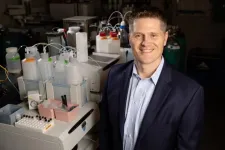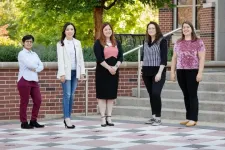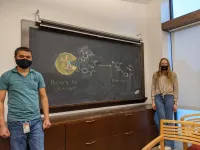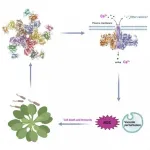Asian scientists grapple with belonging
2021-05-12
(Press-News.org) Asian students and faculty have long been a cornerstone of science in the U.S., drawn by the promise of collaboration and cutting-edge research. However, the Asian community is facing increased racist attacks and scrutiny from the government. A cover story in Chemical & Engineering News, the weekly newsmagazine of the American Chemical Society, explores how Asian scientists are reassessing their futures in the U.S.
In the wake of the COVID-19 pandemic, racist attacks against the Asian community in the U.S. have increased notably, with nearly 4,000 incidents reported between March 2020 and February 2021. Some attribute this to former President Donald Trump's rhetoric about the pandemic originating in China, writes Senior Editor Andrea Widener. Beyond the pandemic, the Trump administration implemented policies that hinder collaborations with researchers in China, including the China Initiative launched by the U.S. Department of Justice in 2018. Initiatives like this have placed Asian researchers under increased scrutiny and suspicion, and many are still in place despite the new presidential administration. Even before Trump and the coronavirus, Asian scientists have said they struggled with feeling welcome in the U.S. due to stereotypes and perceived cultural differences.
These challenging circumstances have led Asian scientists to change how they collaborate with other researchers, recruit students to their labs and choose a career path. Some scientists of Chinese origin in the U.S. have been targeted by investigations from the China Initiative, and they say it's "like walking on eggshells" when disclosing collaborators and funding sources to the government. Visa restrictions and a hostile political climate are also making it harder to recruit international students and for the students to remain in the U.S. after graduation. Some scientists are choosing to return to their countries of origin or seek new opportunities in other parts of the world. While the Biden administration hopes to revise immigration policies and retain U.S.-trained international scientists, the Asian community is fighting for more awareness and tolerance despite an uncertain future.
INFORMATION:
The article, "Asian scientists are rethinking the American dream," is freely available here.
The American Chemical Society (ACS) is a nonprofit organization chartered by the U.S. Congress. ACS' mission is to advance the broader chemistry enterprise and its practitioners for the benefit of Earth and all its people. The Society is a global leader in promoting excellence in science education and providing access to chemistry-related information and research through its multiple research solutions, peer-reviewed journals, scientific conferences, eBooks and weekly news periodical Chemical & Engineering News. ACS journals are among the most cited, most trusted and most read within the scientific literature; however, ACS itself does not conduct chemical research. As a leader in scientific information solutions, its CAS division partners with global innovators to accelerate breakthroughs by curating, connecting and analyzing the world's scientific knowledge. ACS' main offices are in Washington, D.C., and Columbus, Ohio.
To automatically receive news releases from the American Chemical Society, contact newsroom@acs.org.
Follow us: Twitter | Facebook
ELSE PRESS RELEASES FROM THIS DATE:
2021-05-12
TAMPA, Fla. -- Melanocytic nevi, or moles, are nonmalignant growths that arise from pigment producing cells of the skin. They are mostly found in sun-exposed areas; however, they also can be found in sun-protected areas, such as the palms, soles of feet and nail beds, where they are known as acral nevi. While the mutation profile of nevi in sun-exposed areas is well understood, less is known about the genes that are commonly mutated in acral nevi. And while a subset of melanoma of sun-exposed skin arises in nevi, the link between nevi and melanoma in acral skin is poorly understood. In ...
2021-05-12
NEW YORK, NY--While there was extensive use of drug repurposing throughout the first 10 months of the COVID-19 pandemic, there was substantial heterogeneity over the types of drugs used for treatment purposes globally. Some drugs, including hydroxychloroquine, saw sharp declines in use, while adjunctive therapies grew into a more relied upon method for patient management.
In a number of cases, scientific discovery overturned misconceptions proclaimed via press conferences and social media.
The OHDSI network study "Use of repurposed and adjuvant drugs in hospital patients with covid-19: multinational network cohort study," published May 11 by The BMJ, provides a global view ...
2021-05-12
URBANA, Ill. - Gut health is having a moment, with sales of fermented foods such as kefir, kombucha, and kimchi steadily on the rise. The benefits of "good bacteria" in fermented foods and supplements go well beyond the gut, moderating immune responses, heart health, weight, and even mood. But do products hold up to the claims on their labels?
A new study from the University of Illinois and The Ohio State University examined bacterial content of five brands of kefir, a fermented dairy beverage often likened to drinkable yogurt. The research showed the majority of products overstated bacterial density and contained species not included on the label.
"Our ...
2021-05-12
The ability to connect and feel a sense of belonging are basic human needs but new Swansea University research has examined how these are determined by more than just our personal relationships.
Research led by psychologist Professor Andrew Kemp, of the College of Human and Health Sciences, highlights the importance of taking a wider approach to wellbeing and how it can be influenced by issues such as inequality and anthropogenic climate change.
Professor Kemp worked with PhD student Jess Mead and consultant clinical psychologist Dr Zoe Fisher, of the University's Health and Wellbeing Academy, on the study which presents a transdisciplinary ...
2021-05-12
CHAMPAIGN, Ill. -- Young people with diverse gender identities may be bullied and victimized up to three times more often than peers who identify as male or female, a new study of more than 4,464 adolescents in Illinois found.
The students were part of a statewide survey of eighth- through 12th-grade youths in Illinois schools.
"Transgender youths reported the highest rates of all forms of peer victimization, which were double to nearly triple those of males and up to 2.6 times higher than those of females," said social work professor Rachel Garthe of the University of Illinois Urbana-Champaign, who led the research.
"Slightly ...
2021-05-12
Can a protein found in a mosquito lead to a better understanding of the workings of our own brains? Prof. Ofer Yizhar and his team in the Weizmann Institute of Science's Neurobiology Department took a light-sensitive protein derived from mosquitos and used it to devise an improved method for investigating the messages that are passed from neuron to neuron in the brains of mice. This method, reported today in Neuron, could potentially help scientists solve age-old cerebral mysteries that could pave the way for new and improved therapies to treat neurological and psychiatric conditions.
Yizhar and his lab team develop so-called optogenetic methods - research techniques that allow them to "reverse engineer" the activity of specific brain circuits ...
2021-05-12
EAST LANSING, Mich. - As climate change threatens global food security, researchers at Michigan State University are building better beans crucial to human nutrition by tapping into the genetics of the more heat-resistant tepary bean.
The tepary bean (Phaseolus acutifolius A. Gray) is a sister of the common bean which includes kidney, pinto and navy beans. "The common bean is the number one source of protein and nutrients for many people living in Central America and Africa," said Robin Buell, a professor of plant biology in MSU's College of Natural Science and former director of the Plant Resilience Institute.
Her research on bean genetics was published May 11 in Nature Communications.
"Mother nature has already made plants that are adapted to different climates," ...
2021-05-12
Molecules are the building blocks for our modern world, from phones to cars to Doritos. But coming up with new ones is still an incredibly costly and time-consuming process. A group of University of Chicago chemists wants to find a better way.
"If you look at a diagram of a molecule, it seems like you should be able to just snap them together like Tinkertoys, but you can't," said Asst. Prof. Mark Levin. "We'd like to change that."
Their new discovery, published May 12 in Nature, represents a first step towards that transformation: a way to easily cut nitrogen atoms from molecules.
Despite decades of experiments, chemistry remains an art in many ways because molecules are built in a long, iterative process: attaching ...
2021-05-12
In plants, disease resistance proteins serve as major immune receptors that sense pathogens and pests and trigger robust defense responses. Scientists previously found that one such disease resistance protein, ZAR1, is transformed into a highly ordered protein complex called a resistosome upon detection of invading pathogens, providing the first clue as to how plant disease resistance proteins work. Precisely how a resistosome activates plant defenses, however, has been unclear.
A joint team led by Profs. ZHOU Jianmin, CHEN Yuhang and HE Kangmin at the Institute of Genetics and Developmental Biology of the Chinese Academy of Sciences and Prof. CHAI Jijie at Tsinghua University recently employed state-of-the-art electrophysiology and single-molecule imaging to investigate the molecular ...
2021-05-12
Scientists are exploring a number of ways for people with disabilities to communicate with their thoughts. The newest and fastest turns back to a vintage means for expressing oneself: handwriting.
For the first time, researchers have deciphered the brain activity associated with trying to write letters by hand. Working with a participant with paralysis who has sensors implanted in his brain, the team used an algorithm to identify letters as he attempted to write them. Then, the system displayed the text on a screen - in real time.
The innovation could, with further development, let people with paralysis rapidly ...
LAST 30 PRESS RELEASES:
[Press-News.org] Asian scientists grapple with belonging




